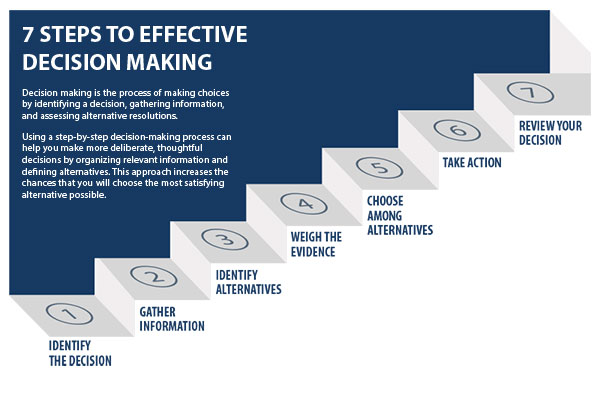Five Steps of Decision Making
1. Clearly define the problem at hand.
2. List all possible decision alternatives. (Why on Earth would you decide this way?)
3. Identify the possible future outcomes for each decision alternative.
4. Identify the payoff (usually profit or cost) for each combination of alternatives and outcomes.
5. Select one of the decision analysis modeling techniques.
Review the Decision, What/Who is Required, Affected By It, How Things Will Change, and What To Do If Problems Are Encountered. Set a timeframe – consider a ‘trial period’ and give yourself leeway to change your mind or change course.
“Have I not commanded you? Be strong and courageous. Do not be afraid; do not be discouraged, for the Lord your God will be with you wherever you go.” “Be on your guard; stand firm in the faith; be courageous; be strong.” – Joshua
The decision modeling techniques presented in the Associated Text are not fit for re-publishing since they attempted to use a matrix and process based on numerical calculations. Decisions are not made this way. Decisions are typically based on numbers, factors, conditions (external, internal, social, political, and business) and are not solely individually made. It is simple to say there are too many factors to consider or delineate as conditions (internal and external) that affect or change the decision, increasing or decreasing the likelihood of the decision itself. Outcomes and predictions are also difficult to forecast, calculate, and make because decisions are not just based on numbers, but also are dependent upon timeframes beyond social economics, law, and policy, but also feelings of more than just the decision maker, which are often considered influencers.
Decisions to change study majors, or Universities is usually based upon personal preference, experience, enjoyment, other people’s perception, internal expectations and perceptions, as well as potential employment and enjoyment futures, which can mildly be forecasted as well as limited by the self and others through the use of pessimistic thinking. Optimistic thinking and knowing is present when one decides to pursue what they love or currently or previously enjoyed without consideration of what could go wrong, but with more weight placed on the process of learning, achieving, and enjoying the journey, rather than forecasting the long term result and demand for such a degree or credential.
